Meteorite fall statistics are frequently used by planetary scientists to approximate the true flux of meteorites on Earth. Meteorite falls are those meteorites that are collected soon after being witnessed to fall, whereas meteorite finds are discovered at a later time. Although there are 30 times as much finds than falls, their raw distribution of types does not accurately reflect what falls to Earth. The reasons for this include the following:
There have been many attempts to correct statistical analyses of meteorite finds for some of these effects, especially to estimate the frequency with which rare meteorite types fall. For example, there are over 100 known lunar meteorite finds, but none has ever been observed to fall. However, for abundant types, meteorite fall statistics are generally preferred.
These statistics are current through June 9, 2012.
For most meteorite falls, even those that occurred long ago or for which material has never received complete scientific characterization, it is known whether the object was a stone, stony iron, or iron meteorite. Here are the numbers and percentages of each type, based on literature data. [1] [2] [3]
| Material | Number | % |
|---|---|---|
| Iron meteorites | 49 | 4.4% |
| Stony-iron meteorites | 11 | 1.0% |
| Stony meteorites | 1042 | 94.6% |
| Total | 1102 | 100.0% |
The traditional way of subdividing meteorites (see Meteorites classification) is into irons, stony-irons, and two major groups of stony meteorites, chondrites and achondrites. For some of the less-studied stony meteorite falls, it is not known whether the object is chondritic; thus the number of meteorites that can be so grouped is 4% lower than shown above. These numbers are shown in the next table. One could make a slight correction for the undercounting of stony meteorites (e.g., the percentage of irons would decrease by a 0.2%), but this was not done.
| Category | Number | % |
|---|---|---|
| Irons | 49 | 4.6% |
| Stony irons | 11 | 1.0% |
| Achondrites | 86 | 8.2% |
| Chondrites | 915 | 86.2% |
| Total | 1062 | 100.0% |
Probably the most useful statistical breakdown of meteorite falls is by group, which is the fundamental way that meteorites are classified. About 5% of the meteorites in the table just above have not been sufficiently classified to allow them to be put into such groups. Again, a small adjustment could be made to the percentages to correct for this effect, but it does not greatly change the results. Note that a number of meteorite groups are only represented by a small number of falls; the percentages of falls belonging to these groups have a large uncertainty.
|
|
| ||||||||||||||||||||||||||||||||||||||||||||||||||||||||||||||||||||||||||||||||||||||||||||||||||||||||||||||||||||||||||||||||||||||||||||||||||||||||||||||||||||||||
| Grand Total: 1003 meteorites | ||||||||||||||||||||||||||||||||||||||||||||||||||||||||||||||||||||||||||||||||||||||||||||||||||||||||||||||||||||||||||||||||||||||||||||||||||||||||||||||||||||||||||
| Epoch | Europe | Asia | North America | Africa | South America | Oceania | Total |
|---|---|---|---|---|---|---|---|
| Pre-1400 | 1 | 1 | 2 | ||||
| 1400s | 4 | 4 | |||||
| 1500s | 2 | 2 | |||||
| 1600s | 9 | 3 | 12 | ||||
| 1700s | 25 | 3 | 28 | ||||
| 1800–1820 | 31 | 7 | 3 | 1 | 42 | ||
| 1821–1840 | 26 | 11 | 9 | 1 | 1 | 48 | |
| 1841–1860 | 42 | 15 | 12 | 1 | 70 | ||
| 1861–1880 | 47 | 36 | 14 | 6 | 4 | 1 | 108 |
| 1881–1900 | 36 | 27 | 20 | 7 | 2 | 92 | |
| 1901–1920 | 27 | 55 | 21 | 10 | 4 | 2 | 119 |
| 1921–1940 | 38 | 55 | 32 | 17 | 14 | 5 | 161 |
| 1941–1960 | 27 | 27 | 18 | 31 | 12 | 3 | 118 |
| 1961–1980 | 19 | 42 | 22 | 29 | 8 | 3 | 123 |
| 1981–2000 | 12 | 49 | 19 | 24 | 4 | 2 | 110 |
| 2001- | 11 | 15 | 12 | 16 | 7 | 2 | 63 |
| Total | 357 | 346 | 121 | 144 | 53 | 20 | 1102 |

A meteorite is a solid piece of debris from an object, such as a comet, asteroid, or meteoroid, that originates in outer space and survives its passage through the atmosphere to reach the surface of a planet or moon. When the original object enters the atmosphere, various factors such as friction, pressure, and chemical interactions with the atmospheric gases cause it to heat up and radiate energy. It then becomes a meteor and forms a fireball, also known as a shooting star or falling star; astronomers call the brightest examples "bolides". Once it settles on the larger body's surface, the meteor becomes a meteorite. Meteorites vary greatly in size. For geologists, a bolide is a meteorite large enough to create an impact crater.

A meteoroid is a small rocky or metallic body in outer space.
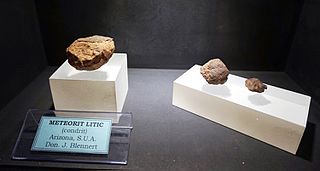
A meteorite classification system attempts to group similar meteorites and allows scientists to communicate with a standardized terminology when discussing them. Meteorites are classified according to a variety of characteristics, especially mineralogical, petrological, chemical, and isotopic properties.

A chondrule is a round grain found in a chondrite. Chondrules form as molten or partially molten droplets in space before being accreted to their parent asteroids. Because chondrites represent one of the oldest solid materials within the Solar System and are believed to be the building blocks of the planetary system, it follows that an understanding of the formation of chondrules is important to understand the initial development of the planetary system.
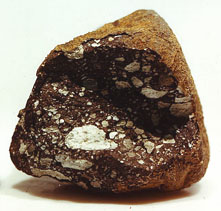
A lunar meteorite is a meteorite that is known to have originated on the Moon. A meteorite hitting the Moon is normally classified as a transient lunar phenomenon.

A chondrite is a stony (non-metallic) meteorite that has not been modified, by either melting or differentiation of the parent body. They are formed when various types of dust and small grains in the early Solar System accreted to form primitive asteroids. Some such bodies that are captured in the planet’s gravity well become the most common type of meteorite by arriving on a trajectory toward the Earth’s surface. Estimates for their contribution to the total meteorite population vary between 85.7% and 86.2%.
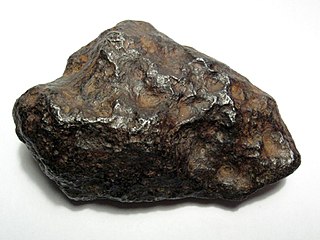
Ataxites are a structural class of iron meteorites with a high nickel content and show no Widmanstätten patterns upon etching.
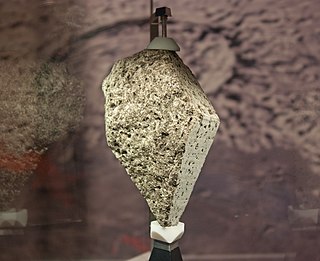
Moon rock or lunar rock is rock that is found on the Earth's Moon. This includes lunar material collected during the course of human exploration of the Moon, and rock that has been ejected naturally from the Moon's surface and landed on the Earth as meteorites.

Troilite is a rare iron sulfide mineral with the simple formula of FeS. It is the iron rich endmember of the pyrrhotite group. Pyrrhotite has the formula Fe(1-x)S which is iron deficient. As troilite lacks the iron deficiency which gives pyrrhotite its characteristic magnetism, troilite is non-magnetic.

The pallasites are a class of stony–iron meteorite.
An asteroid spectral type is assigned to asteroids based on their emission spectrum, color, and sometimes albedo. These types are thought to correspond to an asteroid's surface composition. For small bodies that are not internally differentiated, the surface and internal compositions are presumably similar, while large bodies such as Ceres and Vesta are known to have internal structure. Over the years, there has been a number of surveys that resulted in a set of different taxonomic systems such as the Tholen, SMASS and Bus–DeMeo classification.

Iron meteorites, also known as siderites, or ferrous meteorites, are a type of meteorites that consist overwhelmingly of an iron–nickel alloy known as meteoric iron that usually consists of two mineral phases: kamacite and taenite. Iron meteorites originate from cores of planetesimals.

Mesosiderites are a class of stony–iron meteorites consisting of about equal parts of metallic nickel-iron and silicate. They are breccias with an irregular texture; silicates and metal occur often in lumps or pebbles as well as in fine-grained intergrowths. The silicate part contains olivine, pyroxenes, and Ca-rich feldspar and is similar in composition to eucrites and diogenites.

A meteorite fall, also called an observed fall, is a meteorite collected after its fall from outer space was observed by people or automated devices. Any other meteorite is called a "find". There are more than 1,100 documented falls listed in widely used databases, most of which have specimens in modern collections. As of January 2019, the Meteoritical Bulletin Database had 1,180 confirmed falls.

The Allende meteorite is the largest carbonaceous chondrite ever found on Earth. The fireball was witnessed at 01:05 on February 8, 1969, falling over the Mexican state of Chihuahua. After breaking up in the atmosphere, an extensive search for pieces was conducted and over 2 tonnes (tons) of meteorite were recovered. The availability of large quantities of samples of the scientifically-important chondrite class has enabled numerous investigations by many scientists; it is often described as "the best-studied meteorite in history." The Allende meteorite has abundant, large calcium-aluminium-rich inclusions (CAI), which are among the oldest objects formed in the Solar System.

Pallasovka is a pallasite meteorite found in 1990 near the town of Pallasovka, Russia.
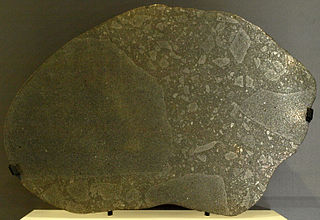
Enstatite chondrites are a rare form of meteorite thought to comprise only about 2% of the chondrites that fall on Earth. Only about 200 E-Type chondrites are currently known.

Primitive achondrites are a subdivision of meteorites. They are classified on the same rank and lying between chondrites and achondrites. They are called primitive because they are achondrites that have retained much of their original chondritic properties. Very characteristic are relic chondrules and chemical compositions close to the composition of chondrites. These observations are explained as melt residues, partial melting, or extensive recrystallization.
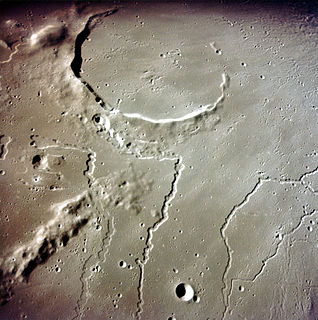
Planetary science or, more rarely, planetology, is the scientific study of planets, moons, and planetary systems and the processes that form them. It studies objects ranging in size from micrometeoroids to gas giants, aiming to determine their composition, dynamics, formation, interrelations and history. It is a strongly interdisciplinary field, originally growing from astronomy and earth science, but which now incorporates many disciplines, including planetary geology, cosmochemistry, atmospheric science, oceanography, hydrology, theoretical planetary science, glaciology, and exoplanetology. Allied disciplines include space physics, when concerned with the effects of the Sun on the bodies of the Solar System, and astrobiology.
This is a glossary of terms used in meteoritics, the science of meteorites.